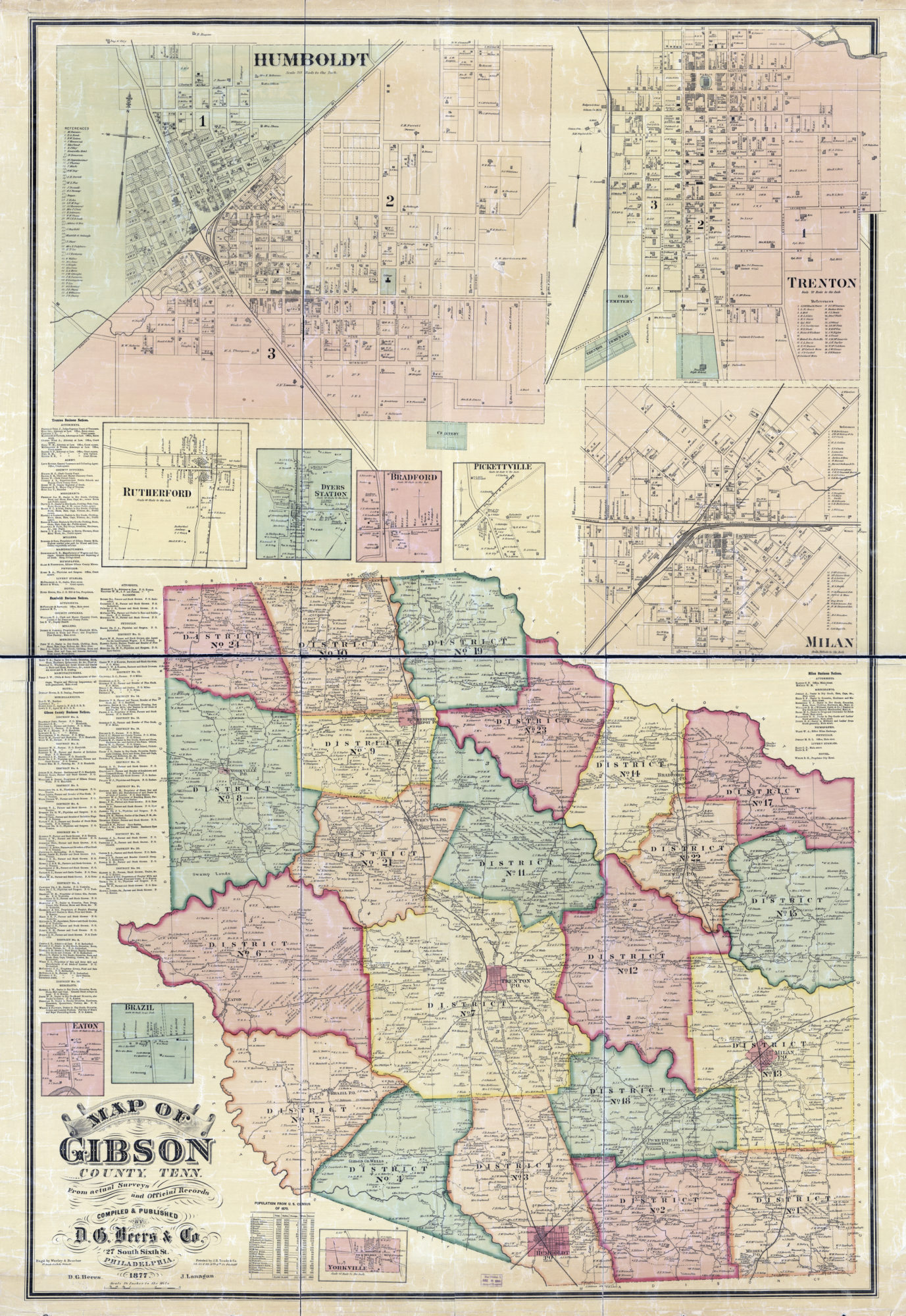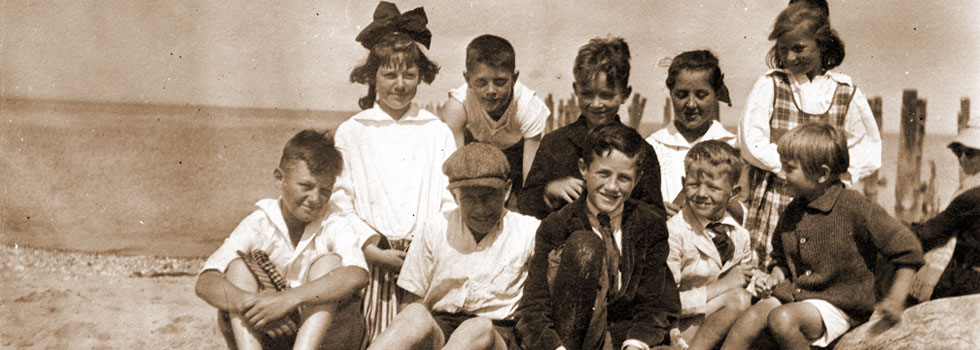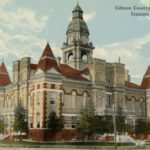Gibson County in West Tennessee, one of the state’s three “grand divisions,” was created in 1832 from the Chickasaw Indian Cession, and is named in honor of John H. Gibson. My third great-grandfather, William Jordan, lived there from around 1820 until his death in 1863.
Located approximately halfway between Nashville and Memphis, Gibson’s county seat is Trenton. Neighboring counties are Carroll, Crockett, Dyer, Madison, Obion, and Weakley. Coxville, Thorps Crossroad, Robertsonville (Crockett Mills) and the land around them were placed in Crockett County at its creation in 1871.
In 1819, the federal government sent survey teams into western Tennessee and Kentucky. Because North Carolina land warrant owners had priority, law suits concerning land titles remained unsettled for the next thirty years. Inadequate transportation also delayed settlement of Gibson County. There were no roads and the north and middle forks of the Forked Deer River could not be navigated by flatboat. Despite these difficulties, settlement was quite rapid after 1822.

1877 Map of Gibson County, Tennessee, Philadelphia, D.G. Beers & Co. Source: https://www.loc.gov/item/2012593687/
Gibson County History
The first white settlement was made in 1819 by Thomas Fite, his brother-in-law John Spencer, and James F. Randolph. They built the first house on the Little North Fork of the Forked Deer, about eight miles east of Trenton. Next, Luke Biggs located about four miles northeast of Trenton. And in the spring David Crockett settled a short distance northeast of Rutherford. After the population reached 500 in 1823, Congressman David Crockett introduced the bill to form Gibson County and named it in honor of Colonel John H. Gibson.
Cities and Communities
This is information that I found in my files, probably from the Tennessee GenWeb.
BRADFORD
Formerly called Kimball, Bradford is in the northeast part of the county, 14th Civil District. The Illinois Central Railroad runs through the center of town and highways 45E, 54 and 105 cross here. Settled before 1853 by James Baker, who gave land in 1886 for the present cemetery, known until 1940 as Baker’s Cemetery.
BRAZIL
Incorporated about 1869 and located in the 4th Civil District, formerly the 5th, about nine miles southwest of Trenton. The first settler near the place was Colonel Shaw. In 1830 John Friason and Cas Simmons, his sons-in-law, joined him. Shaw founded the Old Beulah Church and a part of the cemetery is still there. Bower’s Cemetery is on the Gibson Wells-Brazil Road.
CADES
Unincorporated, located four miles north of Milan on the Illinois Central Railroad.
DYER
James and Mary Bobbitt settled here in 1830. Not incorporated until April 21, 1899, Dyer really began in 1858 with the construction of the Mobile and Ohio Railroad through the area. About the same time B.F. Bobbitt laid off business and residential lots and the town was called Bobbittsville for a short time. Pleasant Grove Presbyterian Church, established May 20, 1848, stood near the present Bobbitt Cemetery. The US Post Office Department changed the name to Dyer on November 29, 1882.
EATON
First known as Buckner’s Bluff and settled about 1824 on the middle fork of Forked Deer River, in the southwest corner of the county. The named was changed in 1827 to honor John Eaton, President Andrew Jackson’s Secretary of War.
FRUITLAND
Located on Highway 45 halfway between Humboldt and Trenton. Began in 1885 when the M & 0 Railroad put in a switch.
GANN COMMUNITY
Settled by 1850 by families from North Carolina and Virginia. Before Gann had a post office, people received their mail at Atwood.
GOAT CITY
Misnomer for a little community on Highway 45 between Milan and Medina. Originally named Centerville, an irate citizen dubbed it “Goat City,” because folks were always “butting in” to other folk’s business. Centerville Cemetery located here.
GIBSON
Known as Pikettville prior to Civil War, the name was changed to Gibson about the time the Memphis and Ohio Railroad (now L & N) was built shortly after 1865. Chartered as Town of Gibson in 1908.
HUMBOLDT
John C. Gillespie set up a store in South Humboldt in the 1850s. By 1870 the population reached 2000 and the town was chartered in 1895. Local women began a library in 1964, now funded by the city.
IDLEWILD
Farming settlement before Illinois Central Railroad was built, formerly known as Thetford and Sprawling.
KENTON
Named for Simon Kenton of Kentucky who surveyed the town. Very early, a road from Troy connected to the road through Weakley County to Hickman, Kentucky, the nearest market for agricultural products. A water mill, used to grind com, was built about 1826 two miles south of Kenton on the Garrison farms. The Mobile and Ohio Railroad was surveyed in 1851 and the first train passed through in 1856 or 57. Known for the famous white squirrels which probably appeared in Kenton over 125 years ago.
MEDINA
Began in 1873 when the Illinois Central Railroad was built, this thriving community was incorporated April 6, 1907.
MILAN
Located about 10 miles northeast of Humboldt and three miles west of the Carroll County line, Milan was settled after 1858 when a train depot was built on the Memphis & Louisville Railroad (renamed Louisville & Nashville). Many early settlers came from Shady Grove, a village settled in 1820 four miles northeast of Milan on the Rutherford Fork of the Obion River. In 1859 Shady Grove post office was moved to Milan. On February 15, 1866, Milan was incorporated and lies in the 13th Civil District. A weekly newspaper, The Milan Exchange started in 1874 is published today as The Milan Mirror-Exchange.
PLEASANT HEIGHTS COMMUNITY
Dates to early 1830’s. James Sherwood Thomas donated land in 1838 for a Mt. Pleasant Cemetery and Church.
RUTHERFORD
Located near Rutherford’s Fork of the Obion River. City was incorporated in 1868. In 1822-23, David Crockett settled his family and party on the Robert Patton grant east of the river. During the next few years,others settled west of the river near the Trenton-Troy Road where Bethlehem Baptist Church was organized in 1833 and the Pond Hill Post Office established in 1849.
SKULLBONE
Settled in early 1800’s by the Smith family, Skullbone was the home of the famous James Gang for a couple of years while Frank James taught at Walker’s School near Holly Leaf.
TRENTON
Trenton, originally known as Gibson-Port is the oldest town in the county and was chosen county seat in 1825. Incorporated on December 17, 1847, Trenton celebrates November 2, 1825 as her birthday. The present day courthouse was built in 1899 and is considered one of the most handsome the state. The first court–known at that time as Court of Pleas and Quarter Sessions–met and was organized January 5, 1824, in the Luke Bigg’s home four miles northeast of Trenton. The post office, originally established in 1824 as Gibson County Court House, was changed to Trenton in 1825. The Western Union was the first newspaper; today’s weekly is The Herald Gazette.
Sources
- “Gibson County,” The Goodspeed Publishing Co., History of Tennessee, 1887. Read this chapter online here at the Tennessee GenWeb.
- Family Search’s Gibson County, TN, Genealogy Page – lots of genealogy resources at this page.


Thank for the History, most enlightening.
Wilkens Callis and family were also one of the first settlers between Dyer and Rutherford in the early 1800’s.
Thank you very much. Informative and interesting. I’m a novice at genealogical research, so every bit of help is appreciated. My paternal grandfather moved from North Carolina to Gibson County by 1835. One of his sons was a businessman (dry goods) in the town of Humboldt for a few years. His parents might have lived in Humboldt itself. I think they attended the Center Baptist Church. I’m still digging to connect the dots.